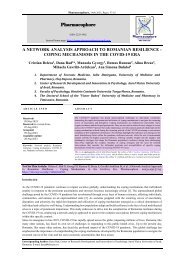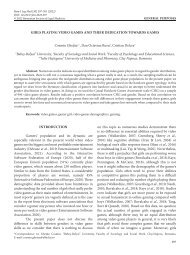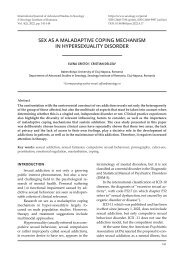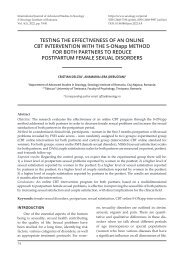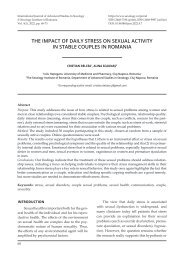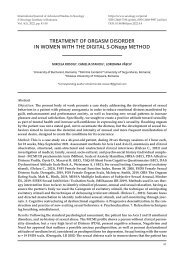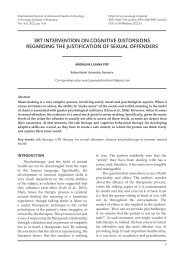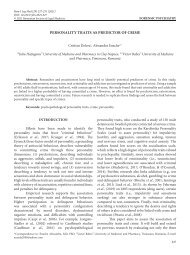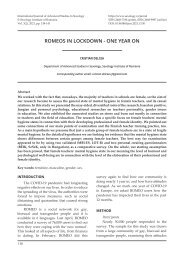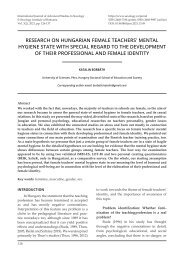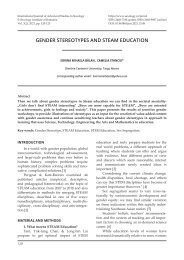ASPECTS REGARDING BULLYING, CYBERBULLYING IN THE FUTURE WORK AND DIGITAL EDUCATION
Context: Digital education is the future of education? The COVID'19 pandemic has certainly affected everyone's lives. Our study started with conceptual definitions like Bullying, Workplace bullying, Cyberbullying. Methodology: Starting from the analysis of the lack of digital skills of trainers and beneficiaries with the help of the SELFIE tool, based on the Framework for digitally competent educational organizations the results are presented. In the first part we have the report with the answers of 87 teachers from Romania, Austria, Poland, Cyprus, Italy and Portugal at SELFIE Questionnaire for Teacher. In the second part we have analyses the answers of 26 leaders, 256 teachers and 1061 students at SELFIE Questionnaire-all levels from Romania and Italy. Contributions: The results of the questionnaires were analyzed and were the basis for writing a Future Work Manual, one Tool Kit and one Mobile App Future Word. How teachers and students will be prepared for the future is essential. Studies have shown that bullying and cyberbullying affect the health of victims. Future As bullying in the workplace or in the classroom is increasingly found in the virtual world in the form of cyberbullying, so are today's students, tomorrow's workers must cope with the changes in digital education.
Context: Digital education is the future of education? The COVID'19 pandemic has certainly affected
everyone's lives. Our study started with conceptual definitions like Bullying, Workplace bullying,
Cyberbullying.
Methodology: Starting from the analysis of the lack of digital skills of trainers and beneficiaries with
the help of the SELFIE tool, based on the Framework for digitally competent educational organizations
the results are presented. In the first part we have the report with the answers of 87 teachers from
Romania, Austria, Poland, Cyprus, Italy and Portugal at SELFIE Questionnaire for Teacher. In the
second part we have analyses the answers of 26 leaders, 256 teachers and 1061 students at SELFIE
Questionnaire-all levels from Romania and Italy.
Contributions: The results of the questionnaires were analyzed and were the basis for writing a Future
Work Manual, one Tool Kit and one Mobile App Future Word. How teachers and students will be
prepared for the future is essential. Studies have shown that bullying and cyberbullying affect the
health of victims.
Future As bullying in the workplace or in the classroom is increasingly found in the virtual world in
the form of cyberbullying, so are today's students, tomorrow's workers must cope with the changes in
digital education.
You also want an ePaper? Increase the reach of your titles
YUMPU automatically turns print PDFs into web optimized ePapers that Google loves.
International Journal of Advanced Studies in Sexology<br />
© Sexology Institute of Romania<br />
Vol. 4(1), 2022, pp. 19-30<br />
https://www.sexology.ro/jurnal<br />
ISSN 2668-7194 (print), ISSN 2668-9987 (online)<br />
DOI: 10.46388/ijass.2022.4.2<br />
<strong>ASPECTS</strong> <strong>REGARD<strong>IN</strong>G</strong> <strong>BULLY<strong>IN</strong>G</strong>, CYBER<strong>BULLY<strong>IN</strong>G</strong><br />
<strong>IN</strong> <strong>THE</strong> <strong>FUTURE</strong> <strong>WORK</strong> <strong>AND</strong> <strong>DIGITAL</strong> <strong>EDUCATION</strong><br />
SOR<strong>IN</strong>A MIHAELA BĂLAN, CAMELIA STANCIU<br />
“Dimitrie Cantemir“ University of Targu Mures, Romania<br />
Corresponding author email: bsorinamihaela@yahoo.com<br />
Abstract<br />
Context: Digital education is the future of education? The COVID'19 pandemic has certainly affected<br />
everyone's lives. Our study started with conceptual definitions like Bullying, Workplace bullying,<br />
Cyberbullying.<br />
Methodology: Starting from the analysis of the lack of digital skills of trainers and beneficiaries with<br />
the help of the SELFIE tool, based on the Framework for digitally competent educational organizations<br />
the results are presented. In the first part we have the report with the answers of 87 teachers from<br />
Romania, Austria, Poland, Cyprus, Italy and Portugal at SELFIE Questionnaire for Teacher. In the<br />
second part we have analyses the answers of 26 leaders, 256 teachers and 1061 students at SELFIE<br />
Questionnaire-all levels from Romania and Italy.<br />
Contributions: The results of the questionnaires were analyzed and were the basis for writing a Future<br />
Work Manual, one Tool Kit and one Mobile App Future Word. How teachers and students will be<br />
prepared for the future is essential. Studies have shown that bullying and cyberbullying affect the<br />
health of victims.<br />
Future As bullying in the workplace or in the classroom is increasingly found in the virtual world in<br />
the form of cyberbullying, so are today's students, tomorrow's workers must cope with the changes in<br />
digital education.<br />
Key words: Bullying, Workplace bullying, Cyberbullying, Future Work, Digital education.<br />
<strong>IN</strong>TRODUCTION<br />
The COVID’19 pandemic has certainly<br />
affected everyone’s lives. If in the past the wars<br />
took place on the battlefield, being marked by<br />
physical aggression, now we are witnessing<br />
new forms of violence. We are increasingly<br />
bombarded by the technological explosion<br />
that causes us not to change the way we think,<br />
the way we work and the way we act. Digital<br />
innovation continues to change every business,<br />
therefore businesses are facing the challenge to<br />
stay ahead of the market.<br />
This is only possible if they are understanding<br />
the threats and the opportunities<br />
which come with a fast changing business environment.<br />
To create smarter, more efficient<br />
businesses is therefore the goal for all enterprises<br />
and employees play a crucial part for the<br />
success of every business.<br />
• But we ask ourselves, what are the<br />
consequences of this technological<br />
explosion?<br />
• Will employees adapt to this future work?<br />
• We can talk about a digital education that<br />
will surely change the world.<br />
19
BĂLAN and STANCIU<br />
• But are the users, physically and mentally,<br />
prepared to face this digital world?<br />
• Will bullying in the workplace or in the<br />
classroom be accentuated in the form of<br />
cyberbullying?<br />
The European Commission launched a<br />
digital education action plan 2018–20 that aims<br />
to undertake EU-wide cooperation initiatives<br />
(i) to scale up the digital readiness of both<br />
general and vocational schools, (ii) to develop<br />
relevant digital competences and skills for the<br />
digital transformation; and (iii) to improve education<br />
through better data analysis and foresight.<br />
(Brolpito, 2018)<br />
1. Bullying, Workplace bullying,<br />
Cyberbullying<br />
Bullying behaviour has always been part<br />
of the human condition. Its visibility level is<br />
not so obvious in current workplace practices<br />
but its existence is in no doubt. (Casimir,<br />
2012). Bullying is a form of youth violence and<br />
an adverse childhood experience (ACE), is any<br />
unwanted aggressive behavior(s) by another<br />
youth or group of youths, who are not siblings<br />
or current dating partners, hat involves an observed<br />
or perceived power imbalance, and is<br />
repeated multiple times or is highly likely to be<br />
repeated. 1 in 5 high students reported being<br />
bullied at schol and more than 1 in 6 reported<br />
being cyberbullied in last year. (Centres for<br />
Disease Control and prevention., 2021). Bullying<br />
is any unwanted aggressive behavior(s)<br />
by another youth or group of youths who are<br />
not siblings or current dating partners that involves<br />
an observed or perceived power imbalance<br />
and is repeated multiple times or is highly<br />
likely to be repeated. (Casimir, 2012), youths<br />
who are experiencing or involved in bullying<br />
may be exposed to other forms of violence<br />
such as child maltreatment, dating violence,<br />
gang violence, other peer violence and delinquent<br />
behavior, suicidal behavior, and abuse<br />
by adults.<br />
The bullying victimization varies across<br />
demographic groups, the youth who was<br />
bullied according: Sex; Race; Ethnicity; Age;<br />
Current grade level; Disability status; Special<br />
education; English proficiency; Religion<br />
(Gladden, p23). But Bullying should not be<br />
confused with violent infections.<br />
The notion of violent crime includes<br />
homicide, bodily harm, crimes against the<br />
family (aggression and aggression against the<br />
spouse or children, abandonment of children,<br />
upset and hitting the elderly, etc.), violent<br />
sexual acts (rape), sexual harassment, robbery,<br />
false imprisonment, terrorism. (Delcea &<br />
Siserman, 2020)<br />
Workplace bullying within the school<br />
context includes a multitude of role players<br />
because teachers may be targeted by their<br />
colleagues, principals, the members of the<br />
management and administrative staff of their<br />
school, parents and learners. (de Wet C., 2021).<br />
Workplace bullying is recognized as an offense<br />
to human dignity in Europe, where the Charter<br />
of Fundamental Rights of the European<br />
Union states that every worker has the right<br />
to working conditions that respect his or her<br />
health, safety and dignity. (Barnes, 2017).<br />
Studies on workplace aggression have been<br />
conducted for over 20 years. The exploratory<br />
study on workplace aggression in higher<br />
education and higher education institutions<br />
in Wales compared „perceptions and experiences<br />
in six areas: workplace harassment, sexual<br />
harassment, racial harassment, sex discrimination,<br />
unfair promotion opportunities and opportunities<br />
reduced promotion. Structured interviews with<br />
20 key informants, a survey of members of<br />
higher education / higher education (NATFHE)<br />
members in Wales and in-depth interviews with a<br />
small number of victims of bullying showed that<br />
respondents hear about harassment at work in the<br />
first place. from the media and not through internal<br />
communications. Survey respondents experienced<br />
higher levels of harassment in the workplace than sex<br />
discrimination, harassment, or racial harassment.”<br />
(Barnes, 2017).<br />
The study “Workplace violence is prevalent<br />
especially among occupations with frequent<br />
client contact.”Analyzed data from 45,905 men<br />
and women (aged 40 to 65) and without diabetes,<br />
and the cohort study has 26,625 women. This are<br />
participated in four studies Participants self-reported<br />
incidents of workplace Bullying and violence at<br />
baseline using questionnaires with similar wording<br />
20
Aspects regarding Bullying, Cyberbullying in the Future Work and Digital education<br />
in all cohorts.” (Xu, 2017). This study showed that<br />
the effects of bullying at work are the cause of many<br />
diseases: ”Researchers assessed incident diabetes<br />
during follow-up with national health and drug<br />
records and used marginal structural Cox models<br />
to examine the associations between workplace<br />
harassment and violence and type 2 diabetes. In the<br />
cohort, 9% reported workplace, and 12% reported<br />
being exposed to workplace violence or threats<br />
of violence. Between 2% and 4% of participants<br />
reported exposure to harassment and violence at<br />
work, although there was little statistical agreement<br />
between the two measures in the studies, according<br />
to the researchers. Over an average follow-up time<br />
of 11.7 years, 1,223 participants developed type 2<br />
diabetes.” (Xu, 2017). The researchers found<br />
that ”participants who reported harassment at<br />
work had a 1.46-fold higher risk of developing type<br />
2 diabetes compared with those who did not report<br />
harassment at work (95% CI, 1.23-1.74). After<br />
further adjustment for BMI (available in three of the<br />
four included studies), HR decreased slightly from<br />
1.55 (95% CI, 1.25-1.92) to 1.37 (95% CI, 1, 11-<br />
1,69). Further adjustments for alcohol consumption,<br />
mental illness and limiting the analysis to the first<br />
4 years of follow-up did not change the results,<br />
according to the researchers.” (Xu, 2017).<br />
While often considered an extension of<br />
“traditional” forms of schoolyard bullying,<br />
cyberbullying has attracted additional<br />
concern because of the unique affordances of<br />
digital technologies. (Carlson & Frazer, 2021)/<br />
in the online context, bullying can be enacted<br />
anonymously, producing a “disinhibition<br />
effect” on perpetrators (Walker, 2013). Just<br />
as studies have shown that bullying has a<br />
negative effect on health, so it has been shown<br />
in studies that Cyberbullying has been linked<br />
to a number of negative health outcomes,<br />
most notably depression, anxiety and suicidal<br />
ideation. (Shohoudi Mojdehi, Leduc, Shohoudi<br />
Mojdehi, & Talwar, 2019)<br />
2. Methods and results of our study-<br />
Future Word<br />
“Dimitrie Cantemir” University of Targu<br />
Mureș, together with five European partners,<br />
started the Erasmus + project <strong>FUTURE</strong><br />
WORD-. We beguines from the analysis of the<br />
lack of digital skills of trainers and beneficiaries<br />
with the help of the SELFIE tool, based on the<br />
Framework for digitally competent educational<br />
organizations (Digcomorg) developed by<br />
the European Commission. (European<br />
Commission, 2021).<br />
Until now 35,000 participants from<br />
around 150 VET schools and 250 companies in<br />
France, Germany, Hungary, Poland, Romania,<br />
Georgia, Montenegro, Republic of Serbia and<br />
Turkey were involved in the piloting (European<br />
Commission, 2021).<br />
SELFIE WBL is an extension of the existing<br />
SELFIE tool, which was launched in October<br />
2018 and has had more than 1.7 million<br />
users. In the report ”SELFIE for work-based<br />
learning”, it is presented the background and<br />
context of the version for the WBL sector and<br />
show all development steps that it has taken<br />
from an initial idea in 2018 to finalisation in<br />
2021. (Hippe, Brolpito, & Broek, 2021).<br />
The SELFIE Questionnaire For Teachers<br />
has applicated and the result has structured in<br />
two parts. In the first part we have the report<br />
with the answers of 87 teachers from Romania,<br />
Austria, Poland, Cyprus, Italy and Portugal,<br />
Picture 1. The structure of participants<br />
In the second part we have analised the<br />
answers of 26 leaders, 256 teachers and 1061<br />
students at SELFIE QUESTIONNAIRE-all<br />
levels from Romania and Italy, see picture 2.<br />
2.1. The stage of Infrastructure and<br />
Equipment<br />
In each country the situation is good,<br />
school has an extensive, reliable and<br />
secure digital infrastructure that facilitates<br />
innovative teaching and learning: classroom<br />
equipment, software, internet connection,<br />
access to adequate learning resources and<br />
programmers, the digital devices for teaching<br />
are available: whiteboards, video projectors,<br />
laptops, tablets, printers, scanners. The digital<br />
devices are functional, are up-to-date and<br />
meet the teaching needs, must be improve in<br />
Italy. The internet access and connection is fast<br />
and reliable and teachers have access to Wi-<br />
Fi throughout the school for teaching. About<br />
data protection can considerate that are security<br />
21
BĂLAN and STANCIU<br />
systems in place (ex: email scanning and<br />
filtering, secure hosted applications, regular<br />
assessment of vulnerabilities or encrypted user<br />
authentication) to ensure the security of staff<br />
and student data. School provides students<br />
with devices, laptops or tablets, that are<br />
adequate, up-to-date and appropriate to the<br />
learning needs of students (picture 3).<br />
Picture 1. First report participants. S.M. Bălan<br />
Picture 2. Second report participants. S.M. Bălan<br />
Picture 3. Infrastructure and Equipment. S.M. Bălan<br />
22
Aspects regarding Bullying, Cyberbullying in the Future Work and Digital education<br />
2.2. About Leadership in Education<br />
About Digital strategy can say that we have<br />
good resolts but can be develop a action plan,<br />
as a list of priorities or as part of a wider school<br />
strategy or improvement plan. School leaders<br />
must involve the teachers in the development<br />
of the school’s digital strategy, school leaders<br />
involve us the teachers in the development of<br />
the school’s digital strategy by recommending<br />
specific tools, content, pedagogical approaches<br />
and objectives, see Picture 4. Leadership in Education.<br />
New ways of teaching must provide devices<br />
or appropriate learning spaces, allowing<br />
flexible class schedules, or setting incentives or<br />
rewards.<br />
Discussion on the use of technology can be<br />
improve with systematic exchange of experiences<br />
and opinions among teachers, students<br />
and school leaders on teaching and learning<br />
with digital technologies.<br />
2.3. What about Continuing Professional<br />
Development (CPD)?<br />
In general, the school’s leaders give good<br />
opportunities and workspaces for teachers<br />
to share with colleagues tips and support on<br />
teaching with digital technologies through, for<br />
instance, mentoring, observing others teaching<br />
or team teaching. See Picture 5. Continuing<br />
Professional Development.<br />
Picture 4. Leadership in Education. S.M. Bălan<br />
Picture 5. Continuing Professional Development. S.M. Bălan<br />
23
BĂLAN and STANCIU<br />
About CPD needs teachers slightly agree<br />
that the school leaders discuss with teachers<br />
about CPD needs for teaching with digital technologies.<br />
Leaders must made dedicated meetings<br />
or surveys for discussing and identifying<br />
CPD needs, about training on subject-specific<br />
teaching with digital technologies, at individual<br />
level and school level.<br />
Teachers agree that they have CPD<br />
opportunities on the use of digital technologies,<br />
specific to the courses teach. Can be organised<br />
by third parties: online courses, workshops or<br />
mentoring.<br />
2.4. Teaching and Learning| Teacher’s<br />
Digital Competence<br />
Most of teachers agree that they search<br />
online for digital educational resources quizzes,<br />
games, lesson plans, simulations, mind maps,<br />
texts, images, audio, video or software. Teacher<br />
slightly agree that they create digital resources<br />
to support teaching. The suggestion is to create<br />
a variety of resources for teaching, such as<br />
mind maps, slideshows, videos or online tests<br />
and quizzes; including presentations or the<br />
movie making.<br />
One recommendation for teachers is to<br />
use digital technologies, such as content management<br />
systems, blogs, wikis or social media<br />
platforms, that allow students to access, create<br />
and share content online. Must be considerate<br />
in the context of COVID 19. Teachers must be<br />
focused in using effective protection methods,<br />
such as strong passwords, antivirus software,<br />
encryption or offline backups, for the handling<br />
or transfer of sensitive data such as names and<br />
addresses of students or exam results.<br />
Requesting equipment, software, platform,<br />
resource same example of a digital technology<br />
funded particularly useful for teaching<br />
are: Quiz lets; E-logbook, Multimedia boards;<br />
Educational website of publishing houses; Kahoot;<br />
Quizizz; Learning Apps; Projector; Tablet;<br />
Lego Mindstorms robots; Other software.<br />
The provided answers show that teachers are<br />
aware of and are using various digital technology<br />
and that they find it useful particularly for<br />
teaching. Can use olso Google suite: Google<br />
classroom, Resources like BBC bites, British<br />
council, ISL collective, Tablet with internet connection;<br />
Microsoft Teams; Office 365; Moodle<br />
Platform; Geogebra; Social Media (Youtube,<br />
Vimeo, Facebook; Instagram, etc.)<br />
Teachers agree that use digital technologies<br />
to tailor teaching to students’ individual<br />
needs must be improve to use digital technologies,<br />
design and implement personalised interventions<br />
by differentiating lesson content and<br />
enabling students to work at their own pace.<br />
Teachers use digital technologies to foster<br />
students’ creativity; must stimulated students<br />
to use technologies: coding tools, or image,<br />
audio- or video-editing software, in new ways<br />
to develop and demonstrate their personal<br />
or collective creativity. Students use digital<br />
technologies for activities that engage them<br />
all, such as open-ended investigations to be<br />
presented in a variety of media involving<br />
online research, citing sources and reflecting on<br />
the learning that has taken place. Can improve<br />
by engaging students in activities that require<br />
group or team work through collaborative<br />
tools, such as interactive whiteboards, wikis,<br />
blogs, discussion forums or video conferencing.<br />
2.5. Assessment Practices<br />
For supporting teachers can use guidelines,<br />
training or incentives in using technologyenabled<br />
assessment practices. Classroom<br />
response systems, quizzes, games, simulations<br />
or e-portfolios can be used to provide students<br />
with personalised feedback during and after<br />
a learning process. Recommendations for<br />
teachers are to use technologies, such as<br />
serious games, simulations or log files, to assess<br />
student skills, for instance communication,<br />
collaboration or problem solving. Using digital<br />
technologies can be considerate to provide<br />
students with continuous and timely feedback<br />
during or just after the learning process:<br />
classroom response systems, pop-ups with the<br />
correct answer in quizzes or serious games.<br />
It is important to enabling students to<br />
use technologies, such as comment features<br />
in apps, virtual learning environments or<br />
discussion forums, to view and comment on<br />
each other’s work. Can enabling students<br />
to use technologies comment features in<br />
24
Aspects regarding Bullying, Cyberbullying in the Future Work and Digital education<br />
virtual learning environments or e-portfolios,<br />
identifying and recording strengths and<br />
weaknesses and setting themselves goals for<br />
improvement. Most problematic issue is using<br />
digital technologies to enable students to<br />
provide feedback on other students’ work.<br />
2.6. Student Digital Competence<br />
Must take in reconsideration methods<br />
and tools for students to improve their skills<br />
in collating and managing online information,<br />
creating digital resources, communicating and<br />
collaborating with others in almost all subjects,<br />
not just in ICT-related ones. Students have<br />
opportunities to learn about online safety, e.g.<br />
not to share personal information or using<br />
strong passwords, and what to do if they have<br />
a problem, e.g. an unwanted contact.<br />
Students must learn how to behave<br />
responsibly when they are online, must think at<br />
opportunities to learn how to behave properly<br />
when they go online, e.g. not sending malicious<br />
messages, not participating in cyberbullying<br />
and not posting rumors:. Must know what to<br />
do in the event of unacceptable behavior by<br />
others.<br />
Students must be teaching to learn how<br />
to check that the information find online, if<br />
the information is reliable and accurate, must<br />
critically evaluate the credibility and reliability<br />
of digital resources they find online, e.g. social<br />
media posts, photos or videos; comparing them<br />
with legitimate sources. Also, must learn more<br />
how to give credit to others’ work they have<br />
found online. Teachers can create opportunities<br />
to teach students to show correctly where the<br />
text, images, audio or videos come from that<br />
they have found online and used for their<br />
assignments.<br />
Can give to student’s opportunities to<br />
remix, edit or create digital resources such as<br />
photos, videos, audio files, and slideshows<br />
or mind maps because students learn to<br />
communicate using digital technologies. Thy<br />
use a variety of technologies: email, a website,<br />
a blog, video conferencing or social media,<br />
with other students or teachers.<br />
3. <strong>FUTURE</strong> <strong>WORK</strong>- Manual and toolkit<br />
The project consortium has developed a Future<br />
Work Manual and a toolkit for instructors,<br />
which includes exercises based on the analised<br />
of the needs, including recommendations for<br />
Future Work skills. To ensure adequate access<br />
to future work skills for beneficiaries, the project<br />
consortium has also developed a mobile<br />
application for beneficiaries “<strong>FUTURE</strong> <strong>WORK</strong><br />
Mobile App”, see picture 6.<br />
The target groups are teachers, trainers<br />
and coaches who deliver digital skills to young<br />
adult learners (16-25) in educational settings,<br />
including non/formal (like work-based<br />
Picture 6. <strong>FUTURE</strong> <strong>WORK</strong> Mobile App. S.M. Bălan<br />
25
BĂLAN and STANCIU<br />
learning), volunteering and other informal<br />
learning.<br />
The manual was developed theoretical<br />
aspects in six differents chapters selected from<br />
partner. Future work might affect some sectors<br />
and jobs/ qualifications more now than other.<br />
To consider this, the project will also refer in the<br />
TOOLBOX’s assignments and real-life cases/<br />
examples to specific work sectors in partnering<br />
countries. The ones where future/ agile work<br />
gaps are higher/ future work trained human<br />
ressources more needed than others.<br />
To understand the needs and gaps in<br />
competences, the project partnership spent<br />
some preparation time contacting experts<br />
and tools like the SELFIE survey. Results are<br />
highlighted in the Needs Analysis Report.<br />
With the project description, they form the<br />
basis for the selection of the following chapters<br />
explored further in this manual – and toolbox.<br />
The manual have 6 chapters:<br />
1st Chapter “Agile and eduScrum framework”<br />
designed by CCIAA Umbria, Italy<br />
and eduScrum team, describes the eduScrum<br />
method agile in teaching, how does eduScrum<br />
works and some suggested further readings,<br />
the examples are destinated to the sector trade.<br />
The second chapter „Using Virtual Learning<br />
Environments”, by SPI Portugal invite the<br />
teachers to find information’s about learning<br />
outcomes, types of Virtual Learning Environments<br />
and how to prepare/ organise a virtual<br />
learning session, exempleficated in the Financial,<br />
Banking And Insurance Activities.<br />
The next chapter, ”Creating Digital Resources”,<br />
designed by Dekaplus, Cyprus indicate<br />
rules for developing a compelling presentation,<br />
how to use a presentation application<br />
effectively and the structure of a Presentation,<br />
with examples in trade work sector.<br />
In chapter four ”Assessment And Reacting<br />
Online”, can find point of view about skills<br />
and competences needed from learning and<br />
examples for difficult clients/customers/guests<br />
in Tourism, Hotels, Restaurants.<br />
Chapter five ”Keeping Data Secure”<br />
designed by BEST, Austry, decribe what<br />
means data security, how to keep data secure<br />
at a workplace and same recommended<br />
further reading exemplificated in information,<br />
communication, mail.<br />
Last chapter ”Student Collaboration”.has<br />
developed by Balan S.M. from “Dimitrie Cantemir”<br />
University of Tg. Mures, and describe<br />
types of tools use for students collaboration,<br />
give same specifical terminology about cyberbulling<br />
and show how to develop a student’s<br />
collaboration in cyberbullying topics, also recommended<br />
further reading, the examples are<br />
in Education and Training, Research Design<br />
Word.<br />
At the end of each chapter there is a reflection<br />
section, where critical thinking exercises<br />
are recommended. The manual is still connected<br />
to Toolkitt, stuctureted also in six chapters,<br />
where you will be able to find exercises with<br />
content related to this manual.<br />
4. Chapter Student Collaboration<br />
An effective team will be one that will<br />
allow members to develop as professionals<br />
and learn from each other (“team learning”).<br />
• Teaching in collaborative teams can<br />
be implemented by all teachers in the<br />
classroom, but what is the situation with<br />
online teaching?<br />
Picture 7. Chapter Student Collaboration. S.M. Bălan<br />
26
Aspects regarding Bullying, Cyberbullying in the Future Work and Digital education<br />
• What tools can be used?<br />
• How can the teacher manage the crisis<br />
situations that arise?<br />
• Are we ready to deal with cyberbullying?<br />
In introduction we say that the best collaboration<br />
tools for students combine productivity<br />
and creativity, motivating students to share<br />
and collaborate on projects, give and receive<br />
feedback, create brainstorming. Second point<br />
is about types of tools use for student’s collaboration.<br />
Specific terminology in the cyberbullying<br />
topics has presented and how to develop a<br />
student’s collaboration in cyberbullying topics.<br />
In the end of the chapter are Examples in Education<br />
and Training, Research Design Word.<br />
5. Training course for teachers<br />
In September 2021, 14 teachers from the<br />
consortium are participated at Terni, in Italy at<br />
a training course, for analyzing and discussing<br />
the intellectual products made. Also, practical<br />
activities were carried out, thus preparing the<br />
piloting stage of the courses and the application.<br />
DCU presented the chapter dedicated to<br />
student collaboration. At the beginning of the<br />
training sessions, we defined specific terms for<br />
cyberbullying, with each participant writing<br />
his / her own definitions on the posts, which<br />
were then presented to the others.<br />
After this stage, the participants were divided<br />
into three groups and received a ticket<br />
with a specific deadline and a case study. Each<br />
team had to present the case study as ingeniously<br />
as possible. Using their ingenuity, they<br />
mimicked, played a role play or even simulated<br />
a TV News. The purpose of this activity is<br />
has to raise awareness and propose solutions.<br />
First group: Cyberstalking.<br />
“Cyberstalking” is the prolonged and<br />
repeated use of abusive behaviors online (a<br />
“course of conduct”) intended “to kill, injure,<br />
harass, intimidate, or place under surveillance<br />
with intent to kill, injure, harass, or intimidate”<br />
a target [See: 18 U.S. Code § 2261A].<br />
Example: Over a 15-year period, a freelance<br />
journalist at Scientific American was the target of<br />
cyberstalking from a man who would go on to steal<br />
her identity and threaten her career. Read her story<br />
at Wired.<br />
What to do: Cyberstalking is a federal<br />
offense, and many states have cyberstalking<br />
laws on the books. If you’re comfortable<br />
contacting law enforcement or seeking the<br />
advice of a lawyer, you might wish to take legal<br />
action against a cyberstalked. Other strategies<br />
include blocking your stalker on social media,<br />
documenting every harassing incident that<br />
occurs in relation to cyberstalking, making<br />
sure your online accounts are protected if you<br />
anticipate identity fraud, and enlisting your<br />
support community.<br />
Second group: Cyberbullying.<br />
Cyberbullying encompasses many<br />
harassing behaviors, but boils down to “willful<br />
and repeated harm inflicted through the use of<br />
computers, cell phones, and other electronic<br />
devices” [Source: Cyberbullying Research<br />
Center].<br />
Example: “In a tragic and now infamous<br />
episode of cyberbullying, a twelve-year-old girl took<br />
her own life in New Jersey.”<br />
What to do: Visit Cyberbullying.org for<br />
the best resources and information related to<br />
cyberbullying.<br />
The third Group: Doxing (aka Doxxing).<br />
The publishing of sensitive personal<br />
information online—including home address,<br />
email, phone number, social security number,<br />
photos, etc.—to harass, intimidate, extort,<br />
stalk, or steal the identity of a target. Short for<br />
“dropping docs,” doxing was a revenge tactic<br />
among ’90s computer hackers, according to<br />
HTML.com.<br />
Example: „After reporting on the police officer<br />
involved in the shooting of Michael Brown in Ferguson,<br />
Missouri, two reporters for The New York<br />
Times were forced to flee their homes when their<br />
personal addresses were posted online in retaliation<br />
for their coverage.<br />
What to do: Check out the Protecting<br />
Information from Doxing section of this Field<br />
Manual for tips on preparing for and preventing<br />
doxing. If you’ve already been subjected to<br />
doxing, immediately report the dox to the<br />
platform on which it appears, and do your best<br />
to assess the threat level to your safety. If you<br />
believe that the doxed information could fall<br />
into the hands of someone intent on harming<br />
27
BĂLAN and STANCIU<br />
you, please consider involving your local law<br />
enforcement immediately.<br />
7. Toolkit for teachers<br />
In toolkit for teachers he have proposed<br />
exercises for collaborative work.<br />
Exercise 1. Both children and adults<br />
spend more and more time using the internet.<br />
Therefore, the risk of becoming a victim also<br />
increases. Thus, cyberbullying is occurring<br />
more and more frequently and refers to any act<br />
of harassment on the internet, which negatively<br />
affects a person or a group. The gives situation<br />
is:”Ann and Jon have been friends for a while. But<br />
Ann quarreled with Jon, and in order to take revenge<br />
on Ann, he created a fake account on a social network<br />
with his ex-girlfriend’s name, using her picture and<br />
personal data. This situation lasts for a long time<br />
and Ann is desperate, she does not know how to get<br />
rid of that account. In this case, Ann is the victim<br />
of the repeated behavior of the aggressor. In order to<br />
scare, infuriate or humiliate her, Ben is using her<br />
identity and to send mischievous messages on her<br />
behalf. What do you think Ann should do?”<br />
Purpose of the activity. At the end of<br />
the activity, learners will be able: to critically<br />
evaluate a cyberbullying, situation which can<br />
have unpleasant consequences for several<br />
people; to argue the importance of support for<br />
victims of cyberbullying; to propose actions to<br />
solve cases of cyberbullying.<br />
Step 1: Group formation - Collaborative<br />
work. Learner’s are divided into four groups,<br />
in cooperative structures. Within these groups,<br />
each member of the group becomes an expert<br />
in the specific assigned topic:<br />
• Topic 1: I know about cyberbullying;<br />
• Topic 2: How to prevent cyberbullying;<br />
• Topic 3: I can intervene in case of<br />
cyberbullying situations;<br />
• Topic 4: How to ask for help, if I am a victim<br />
of cyberbullying.<br />
Step 2. Learners are divided into 4 groups,<br />
they will discuss the assigned topics and<br />
make a poster. After the posters are put up,<br />
each group will appoint a representative, who<br />
will present the poster in front of everyone.<br />
Group 1 will focus on personal perceptions<br />
and opinions. Group 2 will propose general<br />
solutions for the prevention of cyberbullying.<br />
Group 3 will propose solutions in which they<br />
themselves would be the victims. Group 4 will<br />
indicate who they can ask for help and will<br />
propose specific ways to solve cyberbullying<br />
situations.<br />
Step 3. The four posters will be displayed,<br />
one representative from each group will<br />
present the main solutions. Following the<br />
gallery tour method, each group will analyses<br />
the posters and complete their own ideas. Each<br />
group will use a different marker color. Finally,<br />
the solutions will be synthesized. The teacher<br />
/ trainer proposes a first solution: contact the<br />
service provider to report the harassment.<br />
Implementation and Recommendations<br />
for Future Work Skills. Learners are able to<br />
propose solutions that concern themselves and<br />
the aggressor as well as the victim. A list of<br />
actions is distributed to deal with cyberbullying<br />
situations:<br />
• Have you been the victim of similar<br />
situations?<br />
• If the answer is yes, have you taken steps to<br />
demonstrate offensive materials?<br />
• If the answer is yes, did you tell your<br />
friends or did you take steps to stop these<br />
harassments?<br />
• If the answer is no, do you think you need<br />
advice?<br />
• Have you witnessed cyberbullying?<br />
• If the answer is yes, how did you take action<br />
or were you a passive observer?<br />
CONCLUSIONS<br />
The Coronavirus pandemic has resulted<br />
in school and university closures in almost<br />
all countries, affecting up to 91 % of learners<br />
worldwide. (Hippe R, 2021).<br />
Only with a strategic foresight in education<br />
it will be possible to create an impact on the<br />
education and training systems so that they are<br />
better aligned to the needs of and opportunities<br />
offered by the labour market and closer links<br />
businesses and the community so that future<br />
skills gap and mismatches can be avoided.<br />
Through appropriate measures educational<br />
stakeholders can proactively plan for and lead<br />
the necessary change.<br />
28
Aspects regarding Bullying, Cyberbullying in the Future Work and Digital education<br />
The statistical implication of study Keeping<br />
youth safe from Cyberbullying, shows that the<br />
more young people agree to a pact of silence<br />
about what is happening online, the greater the<br />
risk of becoming a victim, aggressor or spectator<br />
in -a cyberbullying situation. (Balas, 2020)<br />
Certainly the consequences of this technological<br />
explosion cannot be estimated. The employees<br />
must to adapting at this future work. A<br />
digital education will surely change the world.<br />
But how are the users, physically and<br />
mentally, prepared to face this digital world,<br />
remain to discover. The bullying in the workplace<br />
or in the classroom still be accentuated<br />
in the form of cyberbullying, But at the global<br />
level, efforts are being made to educate young<br />
people for future work, and special attention<br />
is paid to the health of employees by reducing<br />
bullying or cyberbullying.<br />
The PISA 2025 Learning in the Digital<br />
World assessment presents innovations for<br />
PISA the tests unit are designed as a digital<br />
learning environment where students will<br />
find resources to fill their knowledge gaps.<br />
PISA will provide international comparisons<br />
of students self-regulated learning processes,<br />
including measures of motivation and emotion<br />
regulation. (OECD, 2021).<br />
Not only at the macro level, efforts are<br />
being made to improve life and reduce the<br />
phenomenon of cyberbullying, skiing and<br />
micro. Our Future Word project is just a route<br />
in a system as are other projects implemented<br />
in the educational field. For example, in this<br />
school year 2021-2022 at county level, the<br />
County Center for Resources and Educational<br />
Assistance has carried out a wide-ranging<br />
action to prevent Cyberbullying, involving<br />
more than 450 psychologists and teachers.<br />
We must pay special attention to today’s<br />
young people, tomorrow’s future adults.<br />
Today’s young people - teenagers - are going<br />
through a period of change, when “they are<br />
trying to shape a new identity, changes that<br />
increase the level of stress felt by adolescents,<br />
generating many physiological and emotional<br />
imbalances.”<br />
The digital future is a reality and the power<br />
will be of those who will know how to adopt<br />
new technologies in work processes. Today’s<br />
students will be the future workforce. There is<br />
only one boundary between good and evil - the<br />
cyberbully can be defeated by joint efforts. By<br />
educating today’s youth, we can secure a better<br />
future for them.<br />
REFERENCES<br />
1. Balas, D. I. (2020). Consent Silence in<br />
Cyberbullying. In C. SISERMAN, & C. DELCEA,<br />
MONOGRAPH OF <strong>THE</strong> Interdisciplinary Studies<br />
and Research in the Medico-Legal Field (p. 28). Cluj<br />
Napoca, Romania: Filodiritto Editore. Retrieved<br />
Dec 12, 2021, from https://www.researchgate.<br />
net/publication/344954822_EX23_Monograph_<br />
Monograph_Medico-legal_Romaniadocx<br />
2. Barnes, P. (2017). When the abuser goes to<br />
work … International Laws. Retrieved 12 13,<br />
2021, from https://www.abusergoestowork.<br />
com/legislation/internationallaws/?subscribe=success#blog_subscription-3<br />
3. Brolpito, A. (2018). Digital skills and competence,<br />
and digital and online learning. Turin. Retrieved<br />
12 4, 2021, from https://www.etf.europa.eu/<br />
sites/default/files/2018-10/DSC%20and%20<br />
DOL_0.pdf<br />
4. Carlson, B., & Frazer, R. (2021). Attending to<br />
Difference in Indigenous People’s Experiences<br />
of Cyberbullying: Toward a Research<br />
Agenda. In The Emerald International Handbook<br />
of Technology-Facilitated Violence and Abuse<br />
(pp. 145-163). Emerald Publishing Limited.<br />
doi:doi:10.1108/978-1-83982-848-520211008<br />
5. Casimir, G. M.‐K. (2012). Psychosomatic model<br />
of workplace bullying: Australian and Ugandan<br />
schoolteachers. Employee Relations, 34, 411-428.<br />
doi:https://doi.org/10.1108/01425451211236841<br />
6. Centres for Disease Control and prevention.<br />
(2021). Preventing Bullying. Retrieved 11 16, 2021,<br />
from https://www.cdc.gov/violenceprevention/<br />
pdf/yv/Bullying-factsheet_508_1.pdf<br />
7. de Wet C., J. L. (2021). Workplace Bullying,<br />
Emotional Abuse and Harassment in Schools.<br />
In N. E.-W. D’Cruz P. (Ed.), Special Topics and<br />
Particular Occupations, Professions and Sectors.<br />
Handbooks of Workplace Bullying, Emotional Abuse<br />
and Harassment. Singapore: Springer. Retrieved<br />
12 7, 2021, from https://doi.org/10.1007/978-981-<br />
10-5308-5_11<br />
8. Delcea, C., Siserman C., (2021). The Emotional<br />
Impact of Covid-19 On Forensic Staff. Rom J<br />
29
BĂLAN and STANCIU<br />
Leg Med [29] 142-146 [2021]. DOI: 10.4323/<br />
rjlm.2021.142.<br />
9. Delcea C., Enache A., (2021). Personality Traits as<br />
Predictor of Crime. Rom J Leg Med [29] 2, 227-231<br />
[2021] DOI: 10.4323/rjlm.2021.227.<br />
10. Siserman, C., Fabian, A. M., Delcea, C.,<br />
(2021). The Strengthening of The Mother–Child<br />
Relationship Through Group Work Conducted in<br />
Prisons. Rom J Leg Med [29] 2, 218-226 [2021]<br />
DOI: 10.4323/rjlm.2021.218.<br />
11. Popa-Nedelcu R., Delcea C., Siserman C.,<br />
Carmen Domnariu D. C., (2020). The relationship<br />
between personality disorders and domestic violence<br />
in forensic context. Rom J Leg Med28(2)166-<br />
171(2020). DOI:10.4323/rjlm.2020.166.<br />
12. Delcea C., Muller-Fabian A., Radu C. C., Perju-<br />
Dumbravă D., (2019). Juvenile delinquency within<br />
the forensic context. Rom J Leg Med [27] 366-372<br />
[2019] DOI: 10.4323/rjlm.2019.366.<br />
13. European Commission. (2021). Work-based<br />
learning module brings new dimension to SELFIE<br />
tool. Retrieved 12 8, 2021, from https://ec.europa.<br />
eu/education/schools-go-digital/selfie_news/<br />
work-based-learning-module-brings-newdimension-to-selfie-tool_en<br />
14. Gladden, R. V.-K. (n.d.). Bullying Surveillance<br />
Among Youths: Uniform Definitions for Public<br />
Health and Recommended Data Elements. (N.<br />
C. Control, Ed.) Retrieved 12 2, 2021, from<br />
https://www.cdc.gov/violenceprevention/pdf/<br />
bullying-definitions-final-a.pdf<br />
15. Hippe, R. (2021). Make the most of digital<br />
technologies with the SELFIE tool for VET schools<br />
and work-based learning. Retrieved dec 12, 2021,<br />
from https://ec.europa.eu/education/schoolsgo-digital/selfie_news/make-the-most-ofdigital-technologies-with-the-selfie-tool-forvet-schools-and-work-based-learning_en<br />
16. Hippe, R., Brolpito, A., & Broek, S. (2021).<br />
SELFIE for work-based learning. Luxemburg:<br />
Office of the European Union. doi:ISBN 978-92-<br />
76-41928-0, doi:10.2760/336883, JRC126317.<br />
17. Lewis, D. (1999). “Workplace bullying – interim<br />
findings of a study in further and higher<br />
education in Wales”. (Emerald, Ed.) International<br />
Journal of Manpower, 20(1/2), 106-119. doi:https://<br />
doi.org/10.1108/01437729910268696<br />
18. Shohoudi Mojdehi, A., Leduc, K., Shohoudi<br />
Mojdehi, A., & Talwar, V. (2019). Examining<br />
cross-cultural differences in youth’s moral<br />
perceptions of cyberbullying. Cyberpsychology,<br />
Behavior, and Social Networking, 243-248.<br />
19. Walker, J. C. (2013). Introduction. In D. &. S.<br />
Bauman (Ed.), Principles of cyberbullying research:<br />
Definitions,measures, and methodology (pp. 3-21).<br />
New York: Routledge.<br />
20. Xu, T. (2017, Nov 14). Workplace bullying,<br />
violence increase type 2 diabetes risk. (University<br />
of Copenhagen, Department of Public Health,<br />
Section of Social Medicine) Retrieved dec<br />
12, 2021, from Healio News: https://www.<br />
healio.com/news/endocrinology/20171114/<br />
workplace-bullying-violence-increase-type-2-<br />
diabetes-risk?utm_source=TrendMD&utm_<br />
medium=cpc&utm_campaign=Healio__<br />
TrendMD_1<br />
30




